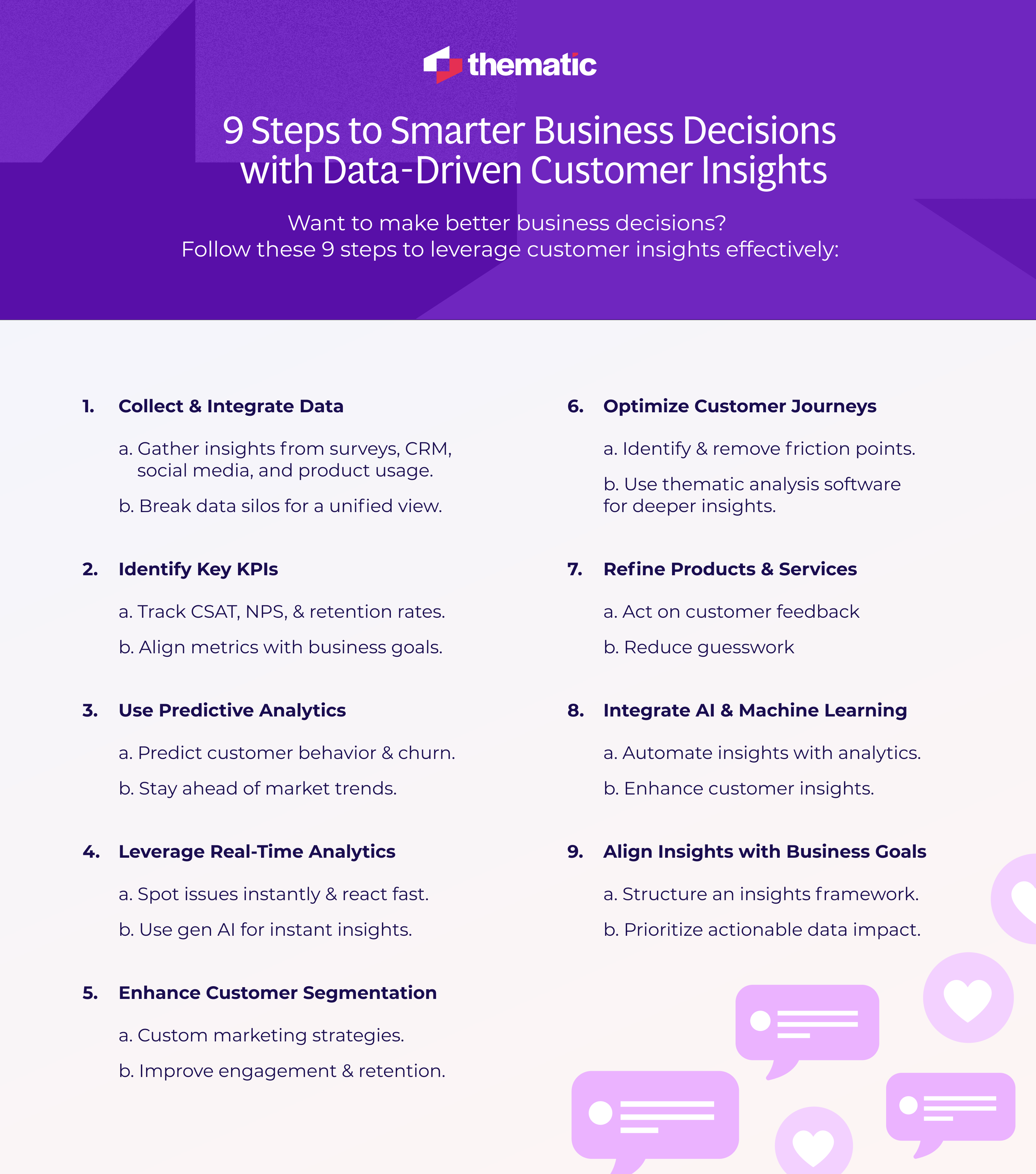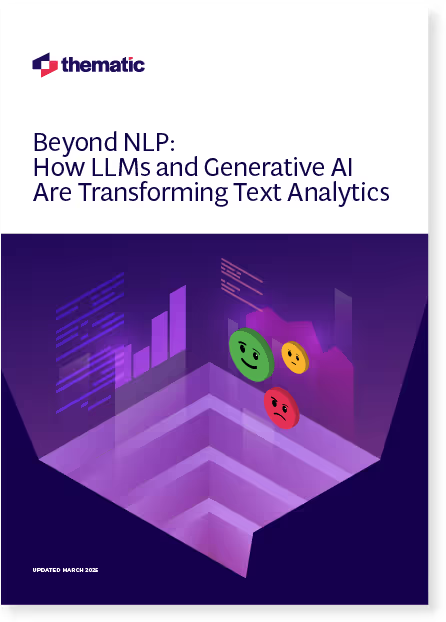
Discover how to leverage data-driven customer insights to make smarter, analytics-powered business decisions that drive growth.

Making business decisions based on gut instinct isn’t a smart strategy anymore. Customer expectations are evolving fast, and the only way to stay ahead is with data-driven customer insights.
The best companies don’t just collect customer feedback—they use it to predict trends, refine products, personalize experiences, and shape smarter strategies across the business.
Consider this: 70% of consumers say they can tell which companies use AI effectively—and which ones don’t. That’s a clear sign that businesses using customer insights effectively have a real competitive edge.
But how exactly do you turn that data into better decisions?
Let’s break it down.
For smarter business decisions, you need more than just raw data—you need actionable insights. Businesses can optimize marketing, improve customer experiences, and stay ahead of the competition by using data-driven customer insights.
Here are the steps.
Every data-driven decision starts with collecting the right information. That means gathering customer data from a range of sources—surveys, CRM systems, support tickets, social media, product usage, and more.
But collecting feedback is only half the battle. The real challenge is integrating it. When teams rely on isolated data sets, it’s nearly impossible to uncover meaningful customer experience insights. Instead, you need unified data analytics to connect every touchpoint and every voice. To make sure this data is as complete as possible, consider using gtm server-side tracking.
Think of customer feedback analysis like laying the foundation for a building. Without structure and integration, your insights will be shaky, and your strategies won’t hold.
Take Instacart. With four very different customer groups—shoppers, consumers, retailers, and advertisers—they were overwhelmed by fragmented feedback. But by centralizing customer feedback using AI-powered text analytics, they gained a clear picture of each group's needs and optimized the experience across the board.
Collecting an integrating data is important to get better insights. Tools like Thematic make it easy to consolidate feedback from every channel so that you can get actionable insights.
Once your data is integrated, the next step is knowing what to measure. Not all data points are equally useful, which is why setting clear KPIs—metrics that reflect success— is essential.
For customer experience teams, KPIs like customer satisfaction score (CSAT), net promoter score (NPS), and customer effort score (CES) help quantify how well you’re meeting customer needs.
For marketing teams, metrics such as customer retention, conversion rates, and social sentiment provide insight into campaign effectiveness.
For product teams, tracking feature adoption and complaint volume reveals what’s working—and what’s not.
Here’s why this step matters:
Ultimately, it helps ensure a boost in customer satisfaction.
So, if your NPS is flat, but customer effort scores are dropping, that signals a friction point in your journey—maybe users are finding it harder to reach support or complete a task. Without those KPIs, you'd be flying blind.
A well-defined KPI framework ensures your data-driven strategy is aligned with what truly matters: real customer outcomes and measurable business growth.
Why wait for problems to arise when your data can predict them?
Predictive analytics helps businesses move from reactive to proactive by using past customer behavior to anticipate future outcomes. With the right approach to qualitative data analysis, you can spot emerging needs, prevent churn, and uncover hidden patterns that drive smarter decisions.
Here’s what this looks like in practice:
Use AI to uncover themes in customer feedback that point to what’s coming next.
If customers of a subscription-based SaaS company often cancel after hitting a certain feature limit in a plan, predictive analysis flags this trend. In response, the team could launch a new plan tier that retains users at a critical point—before they churn.
While it’s important to understand what’s happening, it’s even more important to act early.
Companies that use AI-driven customer insights don’t simply react faster—they stay ahead of the curve. In fact, high-performing businesses are 128% more likely to report strong ROI from their investments in predictive analytics.
That said, not all feedback analytics solutions are created equal. Many tools can surface themes—but only a few offer true predictive capabilities. If you're investing in a platform, make sure it includes AI features like
These are the capabilities that turn feedback into foresight.
Let’s say you’re managing an e-commerce business during the peak holiday season.
A sudden spike in negative reviews pops up about a best-selling product. Without real-time visibility, you’d likely discover this too late—after customer frustration has gone public and returns flood in.
But with a customer insights platform powered by real-time customer insights and analytics, you’re immediately alerted. Within minutes, your support team can send proactive updates, offer alternatives, and manage expectations—turning what could have been a crisis into an opportunity for trust-building.
Now, add generative AI to the mix. Instead of digging through dozens of tickets, your system summarizes themes automatically.
Picture this alert: “Late shipping concerns on X product—West Coast orders affected.” You get actionable context, fast.
That’s the power of agility.
Real-time decisions aren’t just faster—they’re smarter. And companies using real-time analytics are 3.9x more likely to experience transformational impacts on their business.

MYTH: All customers want the same thing—just provide good service.
REALITY: Different customers have different goals, behaviors, and frustrations. Treating them the same leads to missed opportunities and inefficient resource use.
Segmentation helps you shift from blanket strategies to precise, high-impact actions. A strong customer insights framework groups customers based on behavior, preferences, or lifecycle stage—and then delivers tailored experiences to each group.
Why segmentation matters:
Imagine a mid-size SaaS platform offering tools for both freelancers and enterprise clients. By segmenting customers based on usage patterns and team size — data often processed through ELT platforms — they uncover that freelancers need better onboarding support, while enterprise users want advanced analytics. With this insight, they launch in-app tutorials for freelancers and schedule dedicated check-ins for enterprise teams—boosting retention across the board.
Segmentation turns one-size-fits-all into one-size-fits-right.
Every customer follows a journey—from first interaction to long-term loyalty. But where do they drop off, get frustrated, or become superfans? That’s where behavioral analytics and feedback data come in.
Smart businesses use tools like thematic analysis software to pinpoint friction points, understand intent, and uncover hidden patterns across the journey.
Here’s what behavioral analytics can reveal:
In the case of LendingTree, the company analyzed over 20,000 customer comments in just 90 days using Thematic. With that data, they discovered a recurring theme: late-night sales calls were frustrating users—especially across time zones. By identifying this behavior and quantifying its impact, they adjusted communication strategies and immediately improved their NPS and lead engagement.
That’s the power of behavioral insights in action.
Most product decisions start with good intentions—but too often, they rely on internal opinions or anecdotal evidence. The result? Features no one uses, updates that miss the mark, and missed opportunities to really move the needle.
That’s why leading companies are shifting toward customer insights frameworks that ensure every improvement is grounded in real feedback, not assumptions.
This shift means they don’t just collect more feedback; they build a system that connects feedback directly to decision-making across teams.
Look at the case of Art.com. Their teams were overwhelmed by feedback, but insights weren’t reaching the people building the product. After adopting the customer feedback analytics solution, Thematic, they moved from scattered analysis to a centralized framework. Every team could instantly see which issues were impacting customer experience and prioritize changes accordingly.
Instead of acting on gut feel, they now act on clear, quantifiable insights—leading to faster iteration, better alignment, and features customers actually want.
When customer feedback becomes the foundation of your product roadmap, every update starts to hit closer to home.
AI has moved far beyond automation. Today, technologies like natural language processing (NLP), particularly large language models (LLMs), are reshaping how businesses extract meaning from customer feedback.
But these tools don’t deliver value in isolation—they need to be integrated directly into how you collect, analyze, and act on feedback. That’s why more businesses are weaving AI into their customer insights research.
Here’s what that transformation looks like:
Before AI Integration:
After AI Integration:
Imagine a mid-sized eCommerce company swamped with open-text feedback from post-purchase surveys. Before AI, it took weeks to code and categorize themes. Now, with integrated NLP and LLM models, their customer insights research team can automatically tag and summarize comments in real time—highlighting rising issues (like delivery delays in a specific region) before they impact CSAT.
The result? Smarter decisions, fewer missed signals, and a more responsive organization.
Is your Text Analytics solution still relying on B-Grade NLP? Discover how large language models are revolutionizing text analytics, offering deeper insights than traditional NLP approaches.

Collecting data is easy. Acting on it in a way that truly moves the business? That’s the hard part.
A structured customer insights framework is, therefore, essential. It ensures that the insights you uncover aren’t just interesting—they’re directly tied to your goals, whether that's increasing revenue, improving retention, or launching better products.
And it’s especially critical for B2B customer insights, where sales cycles are longer, touchpoints are more complex, and decisions carry higher stakes.
Here’s why this step matters:
Changes don’t have to be massive to matter. As one study puts it, "Even modest improvements in customer loyalty—just 5%—can result in profit increases ranging from 25 to 95%."
Such a return isn’t a fluke—it’s what happens when data-driven customer insights are fully aligned with what the business is trying to achieve.
Whether you're refining your onboarding journey or targeting the right segment for expansion, success depends on closing the gap between insight and impact. And companies leading in AI-driven CX strategies are more than twice as likely to report positive ROI from their efforts.
If the data doesn’t drive a business outcome, it’s just noise.
While the benefits are clear, implementing a data-driven strategy isn’t without obstacles. Here are common challenges—and how to overcome them:

AI-powered software to transform qualitative data into powerful insights that drive decision making.
Companies that use data-driven customer insights are not just responding to changes—they are anticipating them. From collecting customer data to predictive analytics, segmentation, and AI integration, businesses can make smarter, faster, and more informed decisions.
Curious what your customer data is really saying? Book a free demo of Thematic and see how it turns raw feedback into actionable insight—instantly.
Small businesses can start with free or low-cost analytics tools, such as Google Analytics for website behavior, social media insights, and survey platforms like Typeform or Google Forms. They can also focus on qualitative data from customer reviews and feedback to identify trends before investing in advanced analytics solutions.
To balance the use of qualitative and quantitative data, the key is to use the former for context (e.g., customer sentiment, pain points) and the latter for validation (e.g., trends, patterns, and metrics). AI-driven thematic analysis software helps combine both by identifying recurring themes in open-ended feedback and linking them to measurable business outcomes.
Businesses must comply with data protection regulations like GDPR and CCPA by being transparent about data collection, obtaining customer consent, and anonymizing personal information where possible. Implementing secure analytics tools integration ensures that customer insights remain protected while still being valuable for decision-making.
To secure leadership support, demonstrate the ROI of customer insights with case studies, pilot projects, and competitive benchmarks. Show how customer insights research can improve customer retention, reduce churn, and optimize marketing spend. Presenting data in a clear, visual way using dashboards or reports helps executives see the direct impact on business growth.
Join the newsletter to receive the latest updates in your inbox.